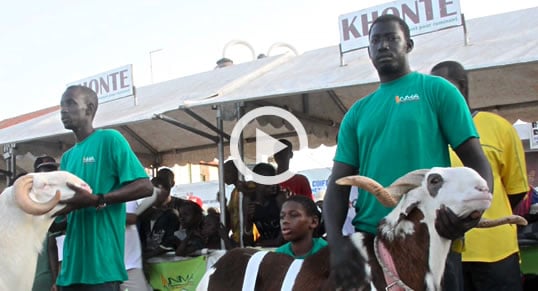 |
| Click above for video. |
Yaya Camara still remembers what happened to him in 1988. It was Tabaski, what people here in Senegal call ‘Id al-Adha—the feast of the sacrifice. Tabaski commemorates Ibrahim’s willingness to follow God’s order to sacrifice his beloved son Ismail who, when saved from the knife, was replaced on the altar with a ram. Every year, Muslims around the world sacrifice an animal in remembrance.
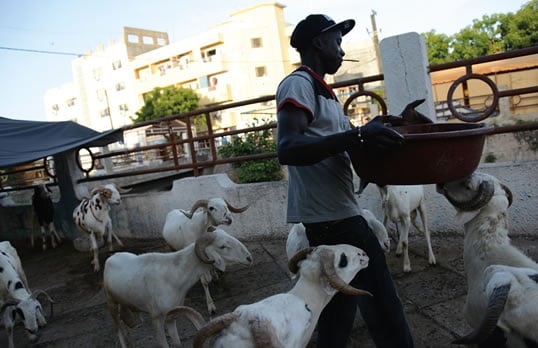 |
| In Dakar, Alioune Badara Dieng is a sheep breeder as well as a plumber, mason, carpenter, fishmonger and, during Tabaski season, a roadside sheep vendor. His business, he says, is bittersweet. “I love them,” he says. “If you sell them today, when you wake up and don't see them, it does something to you.” |
 o, in 1988, Yaya Camara bought his sheep a few days before the holiday in the capital city, Dakar. Camara, who then worked as a night-time security guard, went off to work, leaving the animal tied up outside his apartment building in the care of his wife. She fell asleep, though, instead of looking out for the sheep. In the morning, the sheep wasn’t there. He asked all the neighbors, “Ana sama khar?” (“Where is my sheep?”) But the neighbors hadn’t seen anything, or so they said. “There are so many sheep circulating, that you can’t tell if the sheep is stolen or not,” says Camara. That year his family relied on meat from their neighbors, but he still gets a little sad thinking of it.
o, in 1988, Yaya Camara bought his sheep a few days before the holiday in the capital city, Dakar. Camara, who then worked as a night-time security guard, went off to work, leaving the animal tied up outside his apartment building in the care of his wife. She fell asleep, though, instead of looking out for the sheep. In the morning, the sheep wasn’t there. He asked all the neighbors, “Ana sama khar?” (“Where is my sheep?”) But the neighbors hadn’t seen anything, or so they said. “There are so many sheep circulating, that you can’t tell if the sheep is stolen or not,” says Camara. That year his family relied on meat from their neighbors, but he still gets a little sad thinking of it.
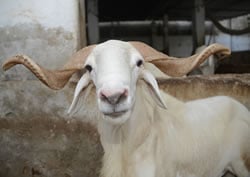 |
 |
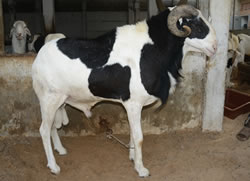 |
| Sheep breeds popular with high-end buyers at Tabaski include, from top down, a mix of bali-bali and touabir, azawad and ladoum; the ladoum is both the largest and the most expensive. |
After that he learned his lesson: Buy the sheep at the last possible minute—the night before or even the morning of the holiday. He tells me this when I ask him, a few days before Tabaski, if he has already bought his sheep. The answer is a resounding “no”: He’d have nowhere to put it. “You risk spending the night with the sheep in your bedroom,” he says.
Still, Camara says, when all goes well and he buys a good sheep for the family, he feels so much pride. “You come in and the wife is going to say, ‘Ah, my husband bought a good sheep!’ And the children even bring their friends over to show them what kind of sheep their father bought,” he says.
In Senegal, a country that is more than 90 percent Muslim, buying that sheep is what every Senegalese family works for in the days leading up to Tabaski. The country becomes gripped by what might be called sheep fever. Colorful billboards advertising everything from margarine to money transfers feature images of sheep or appetizing lamb chops. The phone company sends messages about contests to “win a sheep for Tabaski.” And sheep themselves appear everywhere: riding on the tops of cars and sometimes inside them; grazing in traffic circles and medians; bleating from doorsteps and balconies all over the city.
Mamoudou Ousseynou Sakho is the Senegalese director of livestock and is in charge of the government’s Operation Tabaski, a program to provide enough sheep for each Senegalese household to sacrifice one for the holiday. It is 10 days before the big holiday and Sakho is spending his days fielding calls about the sheep. “Where are they?” is the question on every caller’s mind. “For the moment, Senegal is not self-sufficient in sheep,” he explains. They are waiting for the imports from neighboring countries, facilitated by the government’s temporary suspension of import taxes on livestock. “It’s the problem of supply and demand,” says Sakho. Without the imports, nervous observers are watching the sheep stands and worrying about high prices.
At the sheep markets, only a few sellers have the small—but not too small—sheep that are most in demand because they usually sell for a moderate price, between 60,000 and 80,000 francs cfa (the monetary unit of the West African Financial Community), or approximately $120 to $160. But at one sheep stand, on a grand boulevard in the middle of the city, the sellers are having none of it. A man swathed in royal blue robes and an indigo turban says that these sheep are going for 110,000 francs cfa ($220).
Sakho at the Operation Tabaski headquarters hopes that fresh imports and saturation of the sheep market will help bring down the prices. He has just received word that 180,000 sheep are en route to Dakar; the sheep have already crossed the borders of Mauritania and Mali by truck, car and pirogue and will arrive in the next few days. Sakho reassures me that in the next week there will be an explosion of sheep across Dakar and in the other big cities of Senegal. In a few days, everything will be in place.
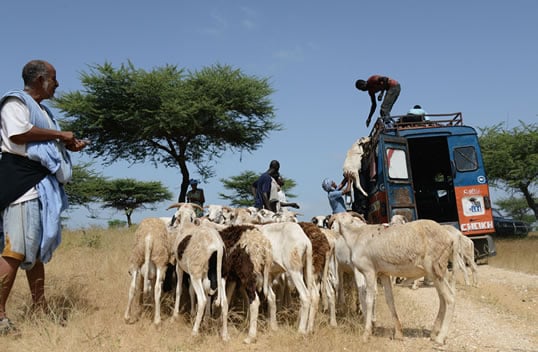 |
| Shepherded south from Mauritania to near Saint Louis in northern Senegal, these sheep are among hundreds of thousands that are imported to Senegal by road and boat in the weeks before Tabaski, when the Senegalese government temporarily suspends livestock import tariffs. |
 cross town, it’s 10 days before Tabaski and Alioune “Bada” Badara Dieng has already set up his sheep stand. Bada, who has many nicknames, including Cash Money and Beugg Ligeey (“Wants to Work”), also has many jobs—plumber, mason, woodworker, sheet-metal worker, screen printer, merchant (of fish and imported goods) and, finally, during the Tabaski season, sheep seller. He sets up shop on a spot next to the bridge over the canal that moves the city’s sewage to the ocean. As the days pass, more sellers arrive with more sheep until most open spaces and boulevards are clogged with them. Wandering street sellers toting Tabaski essentials, like sharp knives and the occasional grill, march back and forth along the canal, searching for customers.
cross town, it’s 10 days before Tabaski and Alioune “Bada” Badara Dieng has already set up his sheep stand. Bada, who has many nicknames, including Cash Money and Beugg Ligeey (“Wants to Work”), also has many jobs—plumber, mason, woodworker, sheet-metal worker, screen printer, merchant (of fish and imported goods) and, finally, during the Tabaski season, sheep seller. He sets up shop on a spot next to the bridge over the canal that moves the city’s sewage to the ocean. As the days pass, more sellers arrive with more sheep until most open spaces and boulevards are clogged with them. Wandering street sellers toting Tabaski essentials, like sharp knives and the occasional grill, march back and forth along the canal, searching for customers.
But in the early days, Bada is mayor of the street; everyone calls out to him as they pass by. Bada has an assortment of sheep that he shows off, stepping on a hoof or pulling a tail to get them to stand up. He has a little bit of every breed and an encyclopedic knowledge of the breeds that he is selling. The peul-peul is a small local sheep, with no distinguishing features, that sells for a modest price for a modest family; the touabir is a thick sheep from Mauritania; the bali-bali is known for its long ears and hails from Niger; and the warale is a peul-peul and touabir mix, celebrated for its colorful coat—sometimes white, gray and brown.
He rounds out the collection with a couple of ladoums, the Ferrari of the sheep breeds, although his are a little past their prime. Ladoums are an improved variety of touabir sheep and famous for their height and their ability to put on the pounds. One passerby stares at the larger ladoum and says, “He’s a champion!” Why? It’s in the way the sheep stands, in his size and the shape of his head, the man replies. Bada’s price for the champion has been fixed at more than $1000 and the passerby shakes his head, saying that the price is too hot. It is early, though, so Bada is being picky. “If I don’t get the price I want [for the ladoum],” he says, “I’ll take it back to the house.” At the $1000 price, Bada is looking for ladoum collectors, not people searching for a sheep to sacrifice for the holiday.
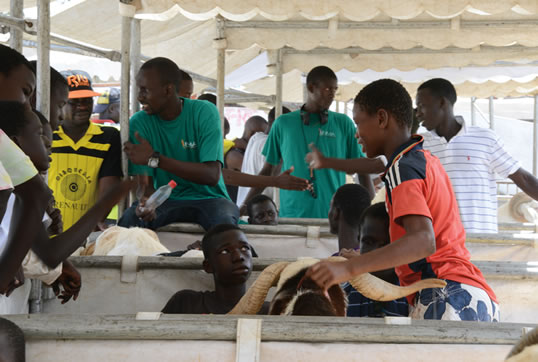 |
| Also in the weeks leading up to Tabaski, the Khar Bii (sheep competition) scours the country for prize-quality sheep, which can sell for up to 100 times the price of an ordinary sheep. Here, semifinalists await judging in Saint Louis. The winners will go to the finals in Dakar. |
In fact, Bada sells all the other sheep to support his stable of ladoums, who live on the rooftop of a building in the Fann Hock neighborhood and enjoy a panoramic view of Dakar and the Atlantic Ocean beyond. Bada bought his first sheep years ago, after a relative died and left him a small inheritance. Although he was only about 10 years old at the time, Bada decided that he wanted to buy a sheep; his father let him. Working with a friend, he started breeding sheep—first just average run-of-the-mill breeds, then building up to the ladoums. His ladoums are a good size, but still can’t compete with the high end of the high end.
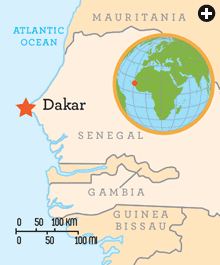 |
That honor goes to someone like Pape Magatte Diop and his brother Ibou, who live just a few blocks away from Bada’s sheep stand. They have several stables of ladoums, some on the roof of the apartment building their family owns and others in a pen in an empty lot next door. Diop claims that his prize sheep, Usain Bolt (named after the famous Jamaican sprinter), is the tallest sheep in Senegal at 113 centimeters (44½"). At the pen, Usain Bolt walks right up to the bar and shoves his face at me; he’s used to being petted. Diop bought Usain Bolt last year for more than $4000 from another breeder. It was worth the investment, he says. “Ladoum sheep, they are the stuff dreams are made of,” Diop tells me. Diop’s goal is to breed Usain Bolt with his female ladoums and see if he can produce an incomparable sheep—the most beautiful, the tallest, the longest, the fattest and the best sheep in Senegal. Maybe he’ll produce a sheep that could compete in the nation’s annual televised sheep beauty contest, Khar Bii.
Every year, in the lead-up to Tabaski, the Khar Bii competition scours the country for Senegal’s most beautiful sheep. The sheep become famous in their own rights. Last year’s winner, a ram named Boy Serere, was so highly prized that one of his offspring (called United Nations) was sold for almost $16,000.
This year, though, because of a longer than usual rainy season, Khar Bii’s search for beautiful sheep in the far-flung regions of the country has just begun. The weekend before Tabaski, Khar Bii holds a semifinal in the northern city of Saint Louis. In the afternoon, everyone—men and women, old people and children—visit the nine pre-selected contestants. Some people snap photos of the sheep; other people snap photos of themselves with the sheep.
Mas Thiaw, a brown sheep who is unique among a line of white sheep, sticks out. Pape Seck, his handler, stays with him while Khar Bii veterinarians weigh him and measure him before his turn on the catwalk (or sheepwalk). “Raising livestock makes me happy,” he says, as he strokes Mas Thiaw’s horns. He does it for the love.
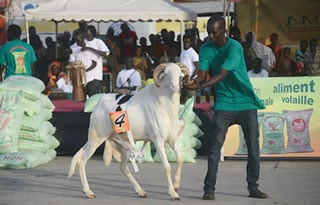 |
| A handler guides a reluctant ladoum—tallest and largest of Senegal’s breeds—out before judges’ eyes at the Khar Bii semifinal. In addition to providing cash rewards to breeders, the contest helps improve the nation's ovine bloodlines. |
In some countries, people buy dogs; in others, people buy sheep. Pape Demba Fall, a geographer at Dakar’s Cheikh Anta Diop University who has studied the nation’s love affair with sheep, says that the animal has many functions in Senegalese society. “It’s an animal that protects you,” according to Fall. It protects you economically by functioning as a living savings account that is easy to liquidate in case of sudden financial difficulty or an event like a wedding. Fall says that, culturally, people also see sheep as good luck. “An all-white sheep might protect the household from bad fortune,” says Fall, explaining the sheep’s role as a mystical protector.
The ladoum obsession, Fall muses, is a natural, albeit expensive, extension of the centrality of the sheep in Senegalese culture, where many people raise sheep in their homes. In Dakar and other cities, they have to stash the animals in courtyards, on sidewalks, in makeshift pens and on rooftops, but they do it all the same. Sheep eat a lot, too, but even if owners have to pay to feed the animal every day, they might get something out of it eventually. And “eventually” means Tabaski, the day when they kill it and get to eat its meat, grilled with onions and served with a bit of mustard and hot sauce on the side.
 hat day comes all too soon. The morning of Tabaski dawns and back at Bada’s stand on the canal, there is nothing left. All the sheep are gone. It was touch and go for a while, though. Just a couple of days before Tabaski, Bada still had more than 20 sheep at his stand. I saw him negotiate with a woman about a ram for more than an hour, before she finally left—without a sheep.
hat day comes all too soon. The morning of Tabaski dawns and back at Bada’s stand on the canal, there is nothing left. All the sheep are gone. It was touch and go for a while, though. Just a couple of days before Tabaski, Bada still had more than 20 sheep at his stand. I saw him negotiate with a woman about a ram for more than an hour, before she finally left—without a sheep.
Bada finally sold his last ram at 4:00 a.m. on the morning of Tabaski. At the end, instead of lowering his prices for the smallest and skinniest sheep, he raised them; buyers, panicked by the late hour, accepted.
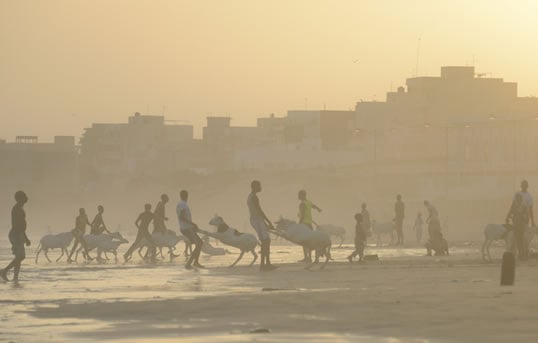 |
| Early in the morning of Tabaski, boys and men bring sheep to Yoff Beach in Dakar to wash the sheep before morning prayers, the sacrificing of the sheep and the cooking of family festive meals. |
A few hours later, steady streams of children lead their sheep to the ocean for one last bath. The neighborhood tailors are still hard at work on the women’s outfits for the day, but most of the men have started to put on their colorful grands boubous in brilliant white and jewel tones with intricate embroidery. The sheep clog the sidewalks and the alleyways behind the houses, ignorant of their fate.
At Bada’s house, there are three sheep and one goat waiting. Bada gave his father a stocky ram with brown spots to sacrifice, not a ladoum but a good-sized animal all the same. Soon, the men of the house go to the mosque; the women stay behind mincing bowls of onions and pounding garlic with mortars and pestles.
After prayers, Bada’s father changes out of his big white boubou into old pants and a tattered shirt. It takes four or five people to subdue the biggest ram and turn it on its side while Bada’s father cuts its throat. The blood spills out onto the sand, a bright red. Eventually, there is a final gasp, a convulsion, a death rattle and it’s done. The family dispatches all four animals in the space of 10 minutes, and then all the men and most of the boys start peeling off the skins, taking out the organs and butchering the animals. The women fire up the grills.
They will use everything: all the meat, the heart and liver, the brain and lungs, even the intestines, once they clean them well. The hooves and head can flavor a soup. Artisans troll for the horns and the skins, to make furniture and leather shoes and bags. The ram’s vocal cords are left to hang over the door for good luck. And beggars go house to house and get a little meat from most families.
Every house in the neighborhood is doing the same thing. Across the bridge, at the house of a rich merchant, they sacrifice eight sheep, all large ladoums. Samba Sarr lives in that house and tells me that Tabaski meat has a special flavor. “It’s not at all the same,” he says. “I can’t explain it, but it’s better than regular meat. Maybe it’s something spiritual.”
Maybe it is that something that transforms the animal from man’s best friend to man’s best meal. After all, when the ram is sacrificed, it is killed with reverence and shared among family and friends. And, everyone, rich or poor, eats well for at least one day on Tabaski.
 |
Jori Lewis (www.jorilewis.com) is an independent writer and a radio journalist based, mostly, in Dakar, Senegal. She writes about food, the environment and agriculture in Africa. |
 |
Ricci Shryock (www.riccimedia.com) is a photo and video journalist based in Dakar, Senegal. Her work has appeared in The New York Times, The Christian Science Monitor and more. This is her first assignment for Saudi Aramco World. |